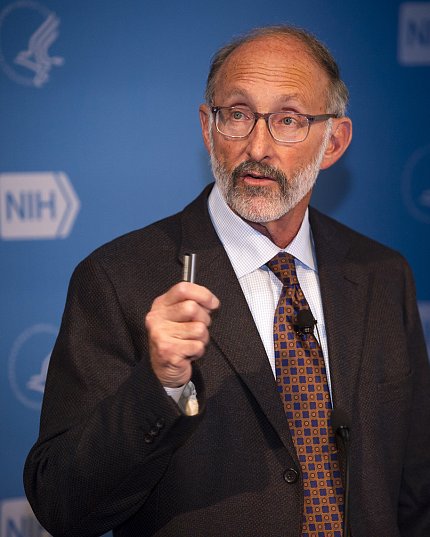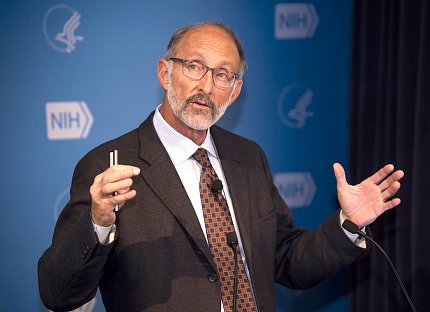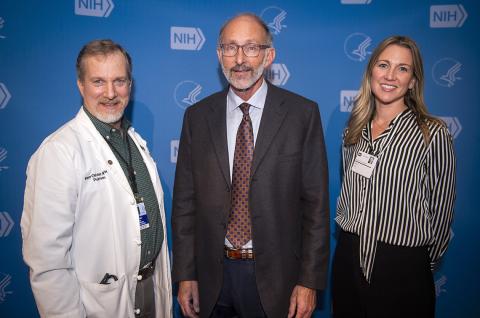The Body Can Rebound
Eating Disorder Damages Are Extensive, But Reversible

Photo: Lisa Helfert
Eating disorders damage nearly every system in the body, but people living with even the most extreme forms of anorexia or bulimia can recover with treatment. Dr. Philip Mehler, founder and executive medical director of ACUTE Center for Eating Disorders at Denver Health, delivered that good news at a recent NIH Clinical Center Grand Rounds.
Mehler, who is also Glassman professor of medicine at the University of Colorado, Denver, began by describing the most familiar eating disorders, which are classified as both mental and physical diseases. ACUTE, a hospital-based inpatient center, treats the medical complications in the most severe eating disorder cases.
Anorexia nervosa (AN), he said, is the restriction of energy intake, leading to significantly low body weight. Patients have a distorted body image and intense fear of weight gain.
“So despite having a BMI [body mass index] of 8, for example,” Mehler explained, “these patients believe they are not too thin.”
AN has two subtypes—restricting calories (non-eating) and binge-eating and purging, which is more common. Purging can involve use of laxatives and diuretics, excessive exercise and self-induced vomiting. Diagnosed cases can be mild, moderate, severe or extreme.
Bulimia nervosa (BN) involves normal-weight individuals who overeat, consume unusually large amounts of food, feel out of control and then engage in purging behaviors—vomiting, laxative abuse, excessive exercise, fasting—to compensate. These patients have an extreme focus on their shape or weight.
“Bulimia is about twice as common as anorexia,” Mehler reported.
Recently, doctors also began diagnosing a relatively new eating problem, ARFID or avoidant/restrictive food intake disorder.
“The basic difference,” Mehler said, “is these patients know they’re thin, hate being thin, but just can’t eat because of an event that happened, such as severe choking. From my perspective, medically speaking, these patients are the same as people with anorexia.”
The eating disorder population is about 90 percent female. In the United States, up to 20 million girls or women suffer from these diseases.
“Generally, it’s a disease of industrialized countries,” Mehler pointed out. “Where food is at a premium, you don’t see anorexia nervosa…Eating disorders are familial diseases. We know that your risk of getting anorexia is much greater if your mother, sister, aunt or grandmother had it.”
Mehler referred to research his group published more than a year ago, documenting the wide range of medical complications that people with anorexia and bulimia experience. The study was the largest ever conducted on eating disorders, following more than 1,000 AN and BN inpatients.
From auditory, cardiovascular and dermatologic to neurologic, ophthalmic and pulmonary, nearly every cell and component of the body suffers from overly restricting energy, Mehler said. Loss of heart muscle, teeth, hair and bone are commonly experienced by people with eating disorders.
“There is no body system that is immune from the ravages of anorexia,” he said. “In bulimia, the complications have to do with the mode and frequency of purging, so if you purge through self-induced vomiting, then you see upper [gastrointestinal] issues, you see teeth issues. If you purge through laxatives, you see rectal prolapse…but at the end of the day, the reason bulimics die prematurely is due to the electrolyte complications that occur as a direct result of purging.”

Photo: Lisa Helfert
Experts agree that when weight for eating disorder patients “is less than 70 percent of ideal body weight, which equates to a BMI of about 14, these people need to be medically stabilized first and that’s what we do on our unit in Denver,” Mehler said.
ACUTE is the country’s only formal Center of Excellence in the eating disorder industry because of the extreme forms of the illness it treats and its acclaimed outcomes over the past two decades.
In terms of prognosis, Mehler said about half of patients recover completely, 30 percent partially recover and 20 percent remain severely ill. AN mortality rate is 5 percent, the highest for any psychiatric disorder. Most frequent causes of death are suicide and medical complications.
Mehler also described several factors that can impede recovery from an eating disorder. Irritable bowel syndrome and superior mesenteric artery (SMA) syndrome, for example, are common in both AN and ARFID populations.
SMA, a digestive condition in which the small intestine becomes partially or completely blocked, can occur during attempts to refeed people to restore them to a healthy weight.
“When food is your enemy and you’re being forced to eat, you suddenly develop a lot of abdominal pain and it really takes skill to ferret out whether it’s SMA or something else,” Mehler said.
Dr. Kenneth Olivier, senior clinician in NHLBI’s Laboratory of Chronic Airway Infection and chief of the Pulmonary Branch, who introduced the guest speaker, had presented Grand Rounds at ACUTE last November. He invited Mehler here to return the favor as a result of their burgeoning collaboration on nontuberculous mycobacteria (NTM ), a serious lung infection that also appears to be a medical complication of eating disorders.

Photo: Lisa Helfert
When patients’ BMIs fall below 14 in both eating disorder and NTM populations, mortality rates escalate. “So the goal would be to try to define the prevalence of covert eating disorders” among people with NTM, said Mehler, explaining the emergent ACUTE-NHLBI alliance.
Throughout the lecture, he continued to circle back to a positive take-home message: Despite the broad range and severity of medical problems that people with eating disorders face, proper care can save their lives in most cases and significantly restore much of their health.
“The good news is that with good treatment and weight restoration and cessation of purging behaviors, these disorders and the complications that we take care of in general are reversible—totally reversible, aside from two notable exceptions”—cerebral atrophy (loss of brain matter that can lead to permanent deficits in cognition, taste and smell) and osteoporosis.
He pointed to results from a 2017 Massachusetts General Hospital longitudinal study that followed people diagnosed with either AN or BN for periods of 16, 20 and 25 years. It found that more than 60 percent of anorexia patients and close to 70 percent of bulimia patients recovered.
“I don’t want to leave with a pessimistic feel,” Mehler concluded. “These are curable illnesses. It’s a young population worth investing the time…There is hope for this disorder. By identifying these patients, getting them into the proper levels of care, we can make a dent in this illness.”
